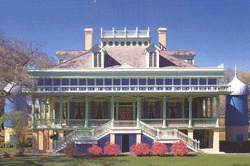SAN FRANCISCO:
Published 12:00 am Wednesday, November 16, 2005
Four owners since 1830, now operated by a foundation
SAN FRANCISCO PLANTATION HISTORY
The property where today’s San Francisco Plantation sits was purchased by Edmond Bozonier Marmillion in 1830, with the house built between 1853 and 1856.
Marmillion unfortunately died in the year the house was completed and one of his three sons, Valsin, managed the estate from then on with his German wife Louise von Seybold. The couple had three daughters who lived in the house as well.
Valsin and Louise put the house through extensive renovations only four years after the home was initially built before the property was sold in 1879 by Louise, who returned to Munich, Germany with her three daughters. Valsin had died at the age of 44.
Buying the plantation in 1879 was Achille D. Bougere, and it was in that year that the plantation’s name was changed to be called San Francisco. The Bougeres bought the mansion complete with furniture, but after selling the house to the Ory family in 1905, took the furniture with them. Unfortunately, that furniture was destroyed in a fire.
In 1954 the property was leased to Mr. and Mrs. Clark Thompson, who opened the mansion to the public. It was in 1974 that Mrs. Thompson moved out, now widowed, and a major restoration began.
The property was bought by Energy Corp. of Louisiana in 1973, then acquired by Marathon Oil in 1976 which donated the house and property to the San Francisco Plantation Foundation, a Louisiana non-profit organization. Marathon agreed to complete the restoration in 1977 at a cost of $2 million.
Marathon continues to help support the plantation with a substantial annual donation to the foundation.
SAN FRANCISCO PLANTATION FACTS
*** A galleried house in the Creole open suite-style.
*** Vividly colored plantation home influenced by the mistress’s Bavarian heritage.
*** Set among live oaks, some as much as 350 years old.
*** One of the finest antique collections in the country.
*** 14 rooms filled with period antiques.
*** World-renowned hand painted ceilings.
*** Located on seven acres of land.
*** Registered as a National Historic Landmark
*** 1830s School House and 1840s Slave Cabin on site.
*** 11,000 square feet, with two water cisterns still on site.
*** Restored to 1860 condition with $2 million project in 1977.
*** 13 foot high ceilings upstairs, with a 25-high ceiling in the attic.
*** 85 percent of original wood still in place.
*** 90 percent of original glass still in place.
*** Lavish interior painting restored by painters from around the world.
*** 26-foot long formal mahogany extension dining table.
*** Cast iron spring rocking chair by the American Chair Company from 1851.
*** Wheeler and Wilson sewing machine from 1852.
*** Terracotta Grecian statues on marbled pedestals.
*** Two water cisterns on either side of the house.
*** Open 360 days a year and most holidays except New Year’s, Mardi Gras, Easter, Thanksgiving and Christmas.
*** $10 per adult; $5 per child; under five free.
*** Tour times: 9:40 to 4:40 (March-Oct.); 9:40 to 4 p.m., (Nov.-Feb.)




